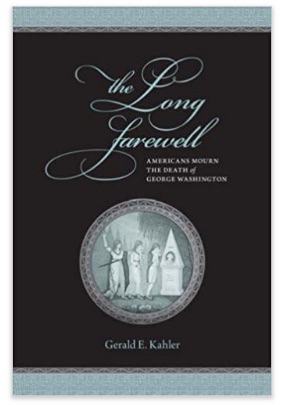In this Virginia History Blog, we look at three titles concerning George Washington and his memory. “The Long Farewell” dealt with how American contemporaries mourned the death of George Washington. “Inventing George Washington” studies the portrait of the Founder in myth and memory. “Here, George Washington Was Born” shows how Washington is remembered, important artifacts related to him, and his birthplace.
The Long Farewell

Gerald E. Kahler wrote The Long Farewell: Americans Mourn the Death of George Washington in 2008. Available from the University of Virginia Press, and online new and used. A companion to David Waldsteicher In the Midst of Perpetual Fetes: The Making of American Nationalism, 1776-1820 (1997).
On George Washington’s death, Americans had an outpouring of mourning rituals. They included processions, memorial services, legislative resolutions, and individual poems, letters and hymns. From his death on December 14, 1799 until the official Congressional day of mourning on February 22, 1800, Kahler counts over four hundred rites of mourning. Eulogies stressed Washington’s overcoming a lack of formal education and his emotional control, his personal courage, his public virtue, and above all his indispensible role in securing independence and establishing the American Constitutional Republic.
Clergymen used the occasion to spark revivals amidst their eulogies. Recalling Washington’s membership in them, the veterans Society of the Cincinnati, and the benevolent fraternal order of Freemasons sought to improve their image and expand membership. The Federalists used the occasion to recall their most famous leader with a mock funeral in Philadelphia and a restatement of Washington’s Farewell Address. Alexander Hamilton organized military ceremonies to advertise the newly organized standing army. Women’s voluntary associations including Abigail Adams used mourning Washington’s death as an indirect way of participating in politics.
To buy “The Long Farewell” on Amazon, click here.
Inventing George Washington

Edward G. Lengel wrote Inventing George Washington: America’s Founder, in Myth and Memory in 2011. It is available from the HarperCollins Press, on Kindle and online new and used. See also Karal Ann Matling George Washington Slept Here (1988).
Lengel frames his study of historical accounts of Washington in two parts. The first is the personal, hidden Washington persona, the second the public display that was meticulously cultivated. Mythology and mis-attributions developed an idealized Revolutionary leader. Lengel himself failed in scrubbing some fluff from the Mount Vernon orientation film. Presidents from Ronald Reagan to Barack Obama have perpetuated Washington mistruths.
Early nineteenth century biographers glorified Washington. Mid-nineteenth century writers published popular biographies and novels celebrating his leadership. Debunkers of the 1920s undermined the narrative of Washington’s infallibility by muckrakers and his simultaneous commercialization. At the bi-centennial of Washington’s birth John C. Fitzpatrick wrote a multivolume of Washington’s life in 1932. In the 1980s James Flexner and Douglas Southall Freeman reimagined Washington as a paradigm of conservatism.
To buy “Inventing George Washington” on Amazon, click here.
Here, George Washington Was Born

Seth C. Bruggeman wrote Here, George Washington Was Born: Memory, Material Culture, and the Public History of a National Monument in 2008. Available from the University of Georgia Press, Kindle and online new and used.
Bruggeman chronicles the decades of scholarly interpretations related to Washington’s birthplace in Westmoreland County, Virginia and the national monument of the restoration house built by the Westmoreland National Memorial Association begun in 1923. Four milestones emerge, the establishment of a shrine by Washington’s relatives, preservation by the women’s philanthropic association, the backing of Congress along with John D. Rockefeller, Jr. of Colonial Williamsburg fame, and the later involvement of the National Park Service. The site is important as an element of material culture to interpret Washington’s life, as an expression of the historical vernacular in Virginia’s Northern Neck, and as an example of the colonial revival style of architecture.
The book explores theories of object-memory relations, the history of living-history interpretation, the emergence of race and gender topics in site management, and the biography of midcentury preservationist Louise DuPont Crowninshield. Bruggeman describes generational and cultural shifts among historic preservationists, both amateurs and professionals, explaining conflicts between aesthetic and scientific “authenticity”.
To buy “Here, George Washington Was Born” on Amazon, click here.
See Also
Current releases related to Virginia history in other eras from Spring 2018 journals can be found in previous Virginia History Blogs at Colonial Virginia – Spring 2018, Revolutionary Virginia – Spring 2018, and Civil War Virginia – Spring 2018, and New South and Modern Virginia – Spring 2018.
Summer journal titles begin with the Colonial Virginia Era i , Colonial Virginia Era ii, Revolution and New Nation, and Jefferson and Madison.
The TVH webpage for Revolution, Constitution and New Nation Eras 1750-1824, features our top title picks taken from the bibliographies of three surveys of Virginia History’s 400 years: two that are widely used in Virginia college courses, and one to be published by the University of Virginia Press in 2019. Titles are organized by topics related to Political and Economic Virginia, Social, Gender, Religious, African American Virginia, and Wars in Virginia during this time span.
The Table of Contents divides Political and Economic Virginia, 1750-1824 into Revolution and Constitution Policy, and New Nation Policy. Topical history is treated under headings of Social History, Gender in Virginia, Religious Virginia and African American Virginian. Finally, two wars are featured under American Revolution and the War of 1812.
General surveys of Virginia History can be found at Virginia History Surveys. Other Virginia history divided by topics and time periods can be found at the webpage Books and Reviews.
Note: Insights for these reviews include those available from articles in the Virginia Magazine of History and Biography, the William and Mary Quarterly, the Journal of the Civil War Era, the Journal of Southern History and the Journal of American History.

